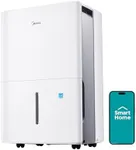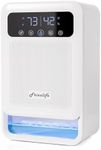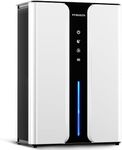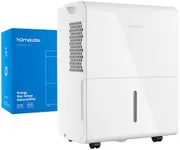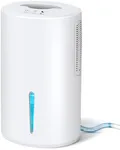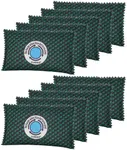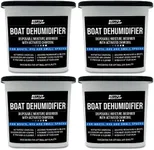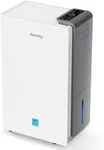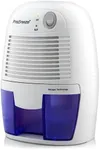Buying Guide for the Best Dehumidifiers With Air Purifier For Home
When choosing a dehumidifier with an air purifier for your home, it's important to consider several key specifications to ensure you select the best fit for your needs. A dehumidifier with an air purifier can help maintain a comfortable humidity level while also improving air quality by removing allergens, dust, and other pollutants. Understanding the key specifications will help you make an informed decision and find a product that meets your specific requirements.Dehumidification CapacityDehumidification capacity refers to the amount of moisture a dehumidifier can remove from the air in a given period, usually measured in pints per day. This spec is important because it determines how effectively the device can control humidity levels in your home. For small rooms or areas with mild humidity, a dehumidifier with a capacity of 20-30 pints per day may be sufficient. For larger spaces or areas with high humidity, you might need a unit with a capacity of 50-70 pints per day. Consider the size of the area you need to dehumidify and the typical humidity levels when choosing the right capacity for you.
Air Purification EfficiencyAir purification efficiency indicates how well the device can remove airborne particles such as dust, pollen, and smoke. This is usually measured by the Clean Air Delivery Rate (CADR), which shows the volume of filtered air delivered per minute. A higher CADR means better air purification. For general use, a CADR of 100-150 is suitable for small to medium rooms, while a CADR of 200 or higher is better for larger spaces. If you have specific concerns like allergies or asthma, look for a unit with a higher CADR and additional filtration features like HEPA filters.
Coverage AreaCoverage area refers to the maximum size of the room or space that the dehumidifier with air purifier can effectively serve. This is usually measured in square feet. It's important to choose a unit that matches the size of the area you need to treat. For small rooms up to 300 square feet, a compact unit will suffice. For medium-sized rooms between 300-600 square feet, a mid-sized unit is appropriate. For large rooms or open spaces over 600 square feet, you will need a larger, more powerful unit. Assess the size of the area you want to dehumidify and purify to select the right coverage.
Noise LevelNoise level is the amount of sound the dehumidifier with air purifier produces while operating, usually measured in decibels (dB). This is important if you plan to use the device in a living area, bedroom, or office where quiet operation is preferred. Noise levels below 40 dB are considered very quiet and suitable for bedrooms. Levels between 40-50 dB are moderate and acceptable for living rooms or offices. Levels above 50 dB may be too loud for quiet environments but could be acceptable in basements or garages. Consider where you will place the unit and your sensitivity to noise when choosing the right noise level.
Energy EfficiencyEnergy efficiency indicates how much electricity the dehumidifier with air purifier uses to operate, often measured by the Energy Factor (EF) or Energy Star rating. This is important for managing your energy consumption and costs. A higher EF or an Energy Star-rated unit will use less electricity to achieve the same results, making it more cost-effective and environmentally friendly. Look for units with an Energy Star rating or a high EF if you are concerned about energy usage. Consider how often you will use the device and the potential impact on your energy bills when selecting for energy efficiency.
Maintenance RequirementsMaintenance requirements refer to the tasks needed to keep the dehumidifier with air purifier running efficiently, such as cleaning or replacing filters, emptying the water tank, and general upkeep. This is important for ensuring the longevity and performance of the device. Some units have washable filters, which are more convenient and cost-effective, while others require regular replacement of disposable filters. Consider how easy it is to access and clean the filters, how often the water tank needs to be emptied, and any other maintenance tasks. Choose a unit with maintenance requirements that fit your lifestyle and preferences.
